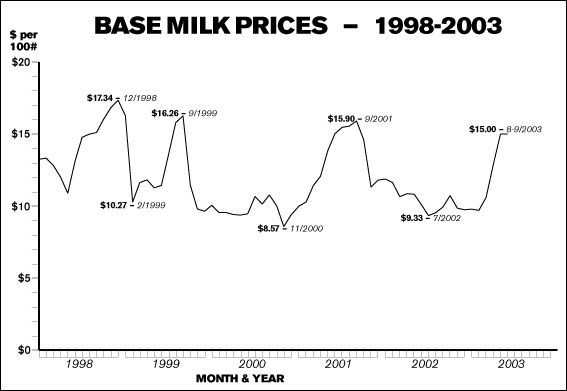Milk prices start to fall after high-priced summer
In August, the base milk price for class three milk hit $15 per hundred weight for the first time since September 2001, but prices have already begun to creep back down.
After hitting a 25-year low in November 2000, milk prices stayed low until early this summer when prices began to turn around. In July 2003, real improvement in dairy prices appeared when the price per hundredweight climbed to nearly $13, said Matt Quade manager of the Associated Milk Producers, Inc., (AMPI) plant in Paynesville.
In August and September, the base price for class three milk - which is used to make cheese - topped $15 per hundred weight, high enough that dairy farmers, stressed from months of low prices, began to pay off old bills with many of them seeing a light at the end of the tunnel, said Quade.
But after two months of good prices, the price of cheese went down 15¢ per pound this week, pulling the October base price down, possibly by as much as $1 per hundred weight, said Quade.
Still, $14 per hundred weight is better than $9.70, the base price in February 2003, said Quade.
The price increase could be due to a decrease in production because of a drought in Minnesota as well as other dairy-producing states in the midwest, said Jim Salfer of the Stearns County Extension Office.
Also, because a lag in the economy - when consumer demand for cheese and premium ice cream was low - was partially responsible for last winter's fall in prices, a recent upturn in the U.S. economy could be responsible for the recent increase in demand, Salfer added.
Quade, however, believes the turnaround has more to do with a newly created program intended to reduce milk production throughout the United States. Co-ops Working Together (CWT) is a program that bought out 300 large dairy producers throughout the country last summer and paid others to reduce their production in an effort to increase milk prices.
Nationwide, milk production was down almost two percent in September, according to the USDA. No matter what caused prices to go up, Quade hopes the price will level out and not drop any more.
According to futures predictions, however, the base could continue to fall somewhat, he pointed out.
Typically, the base price of milk closely follows the futures market, said Salfer. The milk price on Wednesday, Oct. 29, was $14.35. As of Friday, Oct. 31, the November 2003 futures price was $13.16, the December 2003 price was $11.90, the January 2004 price was $11.85, and the February 2004 price was $11.35.
Milk prices are usually low in the winter and spring, said Salfer, and Monday's drop could be because winter is here. If this is the case, the price could also follow a trend of going up in the summer.
According to statistics from the Stearns County Extension Office and the Stearns County Dairy Advisory Committee, in 2001, an average Stearns County dairy farmer milked 62.6 cows that each produced about 17,800 pounds of milk per year. This totals over 1,100,000 pounds of milk per year.
So, for a typical dairy farmer, a $1 difference in milk prices equates to nearly $11,000 per year.

Contact the author at editor@paynesvillepress.com • Return to News Menu
Home | Marketplace | Community